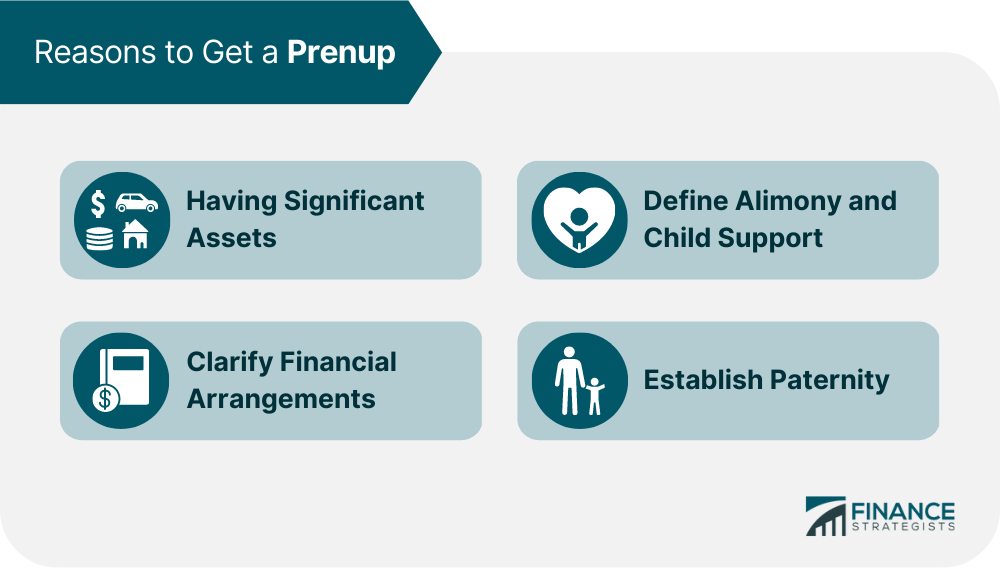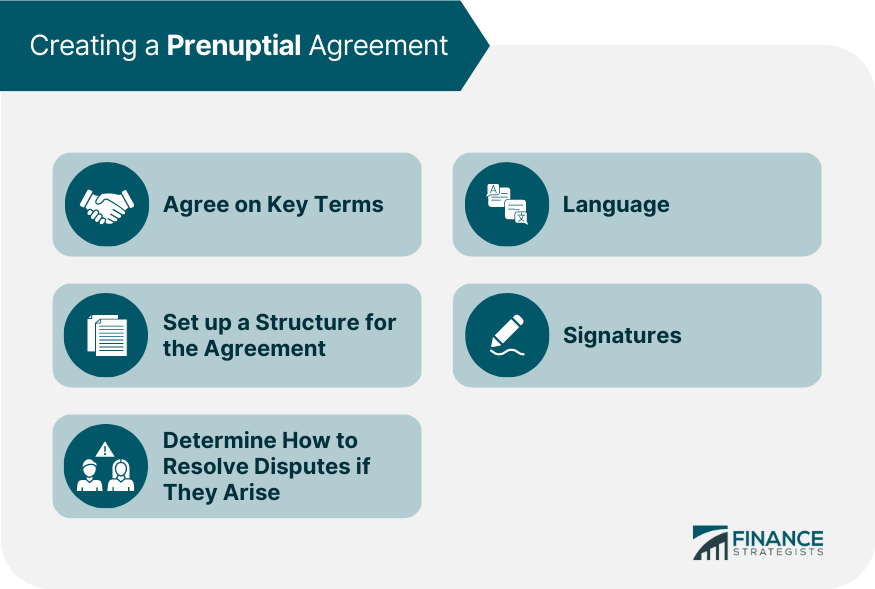A prenup agreement is a contract that two people sign to define what will happen with their property and finances, should they get divorced. The division of property and assets during divorce varies from state to state; therefore, the division of property outlined in a prenuptial agreement may not be upheld by the court. Prenuptial agreements are legal contracts that establish the financial responsibilities of both parties during the marriage and, in some states, after a divorce. In short, a prenuptial agreement is a legally enforceable contract between two people who are planning to get married. Generally speaking, it spells out what happens with their property and finances should they get divorced. There are several reasons why couples might choose to create a prenuptial agreement. Couples may enter into a premarital agreement because they own significant assets, or wish to protect their assets in the case of divorce. Prenuptial agreements can also protect a party's future inheritance. Some couples also use prenuptial agreements to clarify their financial arrangements during the marriage. For instance, they may want to establish who will be responsible for what debts or bills. Prenuptial agreements can also outline the amount and duration of alimony payments, or child support payments, in the case of a divorce. In the case of a divorce, a prenup can protect what has been defined as "non-marital" property. In other words, it can establish paternity - whether a child born during the marriage is legally considered to be the child of just one party. A prenuptial agreement can help protect your future assets in a few ways. Like any other legal agreement, prenuptial agreements have both benefits and drawbacks. Here are some of the primary benefits and drawbacks of a prenup. Prenuptial agreements can protect your assets in the case of divorce if you have significant assets during the marriage. They also provide clarity about financial arrangements. In other words, they ensure that both parties' financial lives are up-to-date and well thought out. Signed prenuptials are usually viewed by the courts as binding contracts, so they can be difficult to overturn. Courts often infer that these documents must have significant weight since both parties signed them. Suppose one party later wants to void (make it null and void) the agreement; this is more likely to be challenged if that person is the spouse with lower income or fewer assets. Prenuptial agreements help protect and define your future assets by establishing who controls them, and how they're divided in case of divorce. States differ on the types of property they consider marital or non-marital. But, in general, the marital estate is everything acquired during the marriage - both assets and liabilities. Who owns assets that are purchased during the marriage often comes down to whether or not they were purchased with marital or separate funds. Marital funds are those acquired by either spouse, while separate funds are those kept separate even during the marriage. There is no single way to draft a prenuptial agreement, but they generally require the same steps as other legal contracts. The following outlines five basic steps that should be included in any prenup: Agree on Key Terms Each party will want to set its own financial expectations about sharing assets and protecting future assets. Set up a Structure for the Agreement Prenuptials need to be clear and organized - including separate provisions governing different types of assets and arrangements for what will happen after a divorce. Determine How to Resolve Disputes if They Arise Many couples include a provision that requires mediation, judicial discretion or arbitration in the event of divorce. Language Write up the agreement using language that is clear and unambiguous to avoid confusion or disputes later on. Signatures Put the final document in writing with both parties' signatures, names and dates it was executed. A notary's signature may also be necessary. Prenuptial agreements are very flexible documents that can be tailored to the needs and circumstances of each individual couple. There are many different ways to create prenuptial agreements, but here are some common examples: If you're planning to get married and already have a prenuptial agreement in place, there are a few extra steps you'll need to take. A prenuptial agreement (prenup) is a legal document signed by couples before marriage that outlines who owns assets and how they will be divided in case of divorce. Prenups are often thought of as being only for couples with significant wealth, but they can also be used as a tool for those who want to keep certain assets separate or protect future inheritances. Prenups help ensure that there will be no surprises if the marriage ends in divorce.Reasons to Get a Prenup

Having Significant Assets
Clarify Financial Arrangements
Define Alimony and Child Support
Establish Paternity
Usage of Prenuptial Agreement
This can be important if you come into the marriage with significant assets that you want to keep separate from your spouse.
This can be helpful if you have a lot of assets that you want to keep separate from your spouse.Benefits and Drawbacks of a Prenup
Benefits
Drawbacks
Protecting Future Assets
Creating a Prenuptial Agreement

Different Types of Prenuptial Agreements
The Process for Getting Married With an Agreement in Place
The Bottom Line
How to Make a Prenuptial Agreement FAQs
A Prenuptial Agreement, or ‘prenup’ for short, is a legally binding contract between two people who are about to be married. It outlines the rights and expectations of both parties in the event that the marriage ends in divorce or death.
A Prenuptial Agreement can provide peace of mind to both parties, as it ensures that their interests will be protected in the event of a divorce or death. Additionally, it allows couples to discuss important financial issues prior to marriage, helping to avoid disagreements later on.
The specifics of a Prenuptial Agreement will vary depending on the individual needs and preferences of the couple. Generally, however, they should include provisions regarding the division of property in the event of a divorce or death, as well as any other financial or estate-related matters.
Making a Prenuptial Agreement involves several steps, including consulting with a lawyer to ensure that the agreement is legally binding and meets all requirements in your jurisdiction. Additionally, it is important to make sure that both parties fully understand the terms of the agreement and agree to them before signing.
Generally, it is recommended that a Prenuptial Agreement should be signed at least 30 days prior to the wedding day. This allows both parties sufficient time to review the agreement, understand its contents, and seek legal advice if necessary. Additionally, some jurisdictions may require a longer waiting period before the agreement can be legally binding. It is important to check with your local laws for more information.
True Tamplin is a published author, public speaker, CEO of UpDigital, and founder of Finance Strategists.
True is a Certified Educator in Personal Finance (CEPF®), author of The Handy Financial Ratios Guide, a member of the Society for Advancing Business Editing and Writing, contributes to his financial education site, Finance Strategists, and has spoken to various financial communities such as the CFA Institute, as well as university students like his Alma mater, Biola University, where he received a bachelor of science in business and data analytics.
To learn more about True, visit his personal website or view his author profiles on Amazon, Nasdaq and Forbes.











